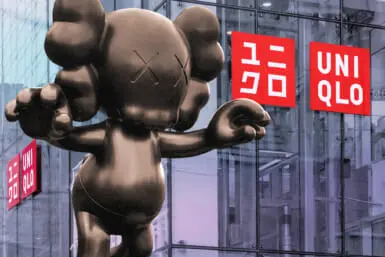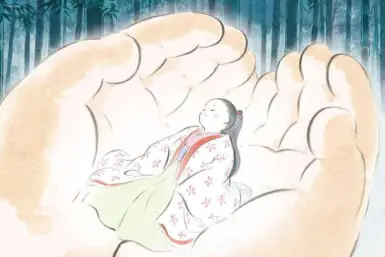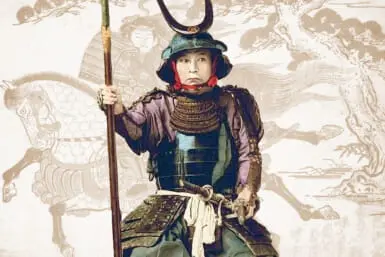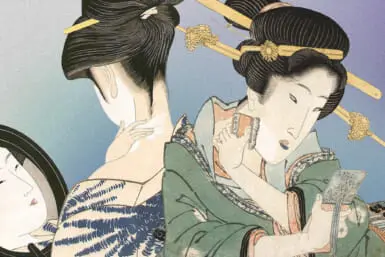I recently had the pleasure of interviewing Natalie Jacobsen about her debut novel, Ghost Train, set in 1877 Kyoto during the Meiji Restoration. The story follows Maru Hosokawa, the daughter of a samurai who has laid down his sword in support of the new emperor. As her father works away from Kyoto, Maru must hide her identity by working in a tea house run by a harsh geiko.
Fans of Shogun, Tokyo Vice, and readers of Foul Lady Fortune by Chloe Gong, Dark and Shallow Lies by Ginny Myers Sain and She Is a Haunting by Trang Thanh Tran are sure to love Jacobsen’s story, which was released last month.

What Inspired Ghost Train
It was back in 2010 when Jacobsen first started thinking about writing a novel set in Japan in the late 19th century. At the time, she was studying Japanese culture and history in college and became fascinated by how folklore was so often woven into everyday life.
“I became particularly interested in the Meiji era and how technological changes impacted the psyche of people experiencing it,” she says. “We often hear from emperors and samurai, but I wanted to explore the experiences of everyday citizens.”
Inspired by true historical events and yokai myths, Ghost Train captures the essence of what life was like in Kyoto almost 150 years ago amid the sweeping changes that were taking place back then, including the Westernization of Japan and a technological revolution. Maru’s journey highlights how fragile the rights of citizens were as Japan transitioned under Emperor Meiji. At the time, people had to confront authority figures to protect their livelihoods.
During a summer festival in Kyoto, ghosts start to appear before Maru. She begins to question the integrity of her friends, colleagues and even her father, who swore he’d be back from an important work trip by this point.
In her search for the truth, she gets some answers from a mysterious talking fox that needs help to confront a powerful demon that is terrorizing Kyoto. As more and more ghosts emerge, young women begin to disappear. Fear rattles the city. Maru must navigate a web of rumors, including unsettling claims that the emperor’s revolutionary new train runs on blood.
Jacobsen referenced a huge number of documents in order to accurately represent the experiences of ordinary people in the era. She began by diving into Japanese literature from the Edo and Meiji periods, scouring references by researchers such as Amy Stanley, author of Stranger in the Shogun’s City, and consulting with Japanese historians. She approached the task like a journalist. The process was, therefore, a lengthy one.
“Once the draft itself was finished, I then spent two years refining the story, cross-referencing and ensuring all the details were accurate,” she tells me.
A Cultural Exploration of the Period
Ochaya, or tea houses, were establishments that were run by women, geiko or geisha, to entertain paying guests with storytelling, conversation and musical performances. In Ghost Train, the ochaya setting serves as a critical narrative device for the main character to learn contrasting viewpoints, dark rumors and horror stories about recent changes in society, all while hiding her true identity from both her clients and her colleagues.
“The difference between geiko and geisha is primarily one of dialect,” explains Jacobsen. “Geiko and maiko originated in Kyoto. When ochaya branched out to other northern parts of Japan, geiko changed to geisha, but maiko remained the same.
There are many misconceptions about geiko and geisha outside of Japan today, many stemming from World War II and the media which blurred the lines between workers in ochaya and sex workers. In the story, the head geiko expresses her frustration with her profession being mixed up with sex workers such as oiran (high-ranking courtesans). Ochaya were not only found in entirely different districts to the brothels of the time, but its workers were typically forbidden from partaking in sex work.
Jacobsen intentionally aims to step away from common stereotypes with her portrayal of geiko and samurai by avoiding clichéd word choices like “honor” and “respect.” This choice was to show that they were normal, complex individuals with their own beliefs and reactions to the changes going on during the period, regardless of their professions.
While writing, Jacobsen was also captivated by the balance of Shintoism and Buddhism in Japan. She feels the overlap between the two made the country unique, even though many Japanese people don’t identify as religious.
The tension during the Meiji era, when Buddhism was temporarily banned, also fascinated her, leading her to want to explore the psychological impact of that period, how it garnered a feeling of nationalism in the country and how the relationship between tradition and modernity began to develop.
Of course, the book is also full of ghosts and Japanese folklore. Jacobsen says her favorite yokai in Japanese folklore is Shirime, a harmless spirit who enjoys startling people with its curious anatomy, before running off laughing.
She thinks the scariest spirit to encounter in the real world would be any kind of onryo, which are vengeful, typically female, spirits that were wronged during their lifetimes, and a type of yurei explored within Ghost Train. One example of an onryo is Oiwa, who slit her throat after being agonizingly disfigured by her disloyal husband, then proceeded to haunt him for the rest of his life.

The Future of Maru’s Story
Jacobsen’s storytelling has a vivid visual quality, so it is easy to imagine a film or TV adaptation of Ghost Train. She would love to one day see the story adapted as an animated movie, envisioning the product as a blend of Cinderella and Princess Mononoke. Before that, she would like to see the novel translated into Japanese.
The book should appeal to a wide audience. It’s a good introduction for newcomers to Japanese history while also providing depth for those familiar with the culture. At the end of the book there is an extensive glossary explaining Japanese terms that are hard to translate into English.
“I hope the book encourages readers to go on to explore more works by Japanese authors,” she says.
According to Jacobsen, two sequels of the story have already been written, so hopefully, readers won’t have to wait too long until the next parts of the story are released.
Jacobsen’s Journey to Japan
Jacobsen’s own journey to Japan began when she was part of a Japanese exchange program between Waseda University and the University of Oregon. Another fun link to Japan is that she is best friends with Nicholas Edwards, also known as NYK, a pop star here whom she worked with in the media. It’s a connection that she says really deepened her “interest in Japanese culture.”
After leaving Japan, Natalie kept thinking about a story involving the folklore of phantom locomotives she learned about in college.
“I witnessed Japan’s transformation from 2010 to 2016, during which time, social media began to flourish,” she says. “When I returned to the States, events like Donald Trump’s election and Brexit made me reflect on the effects of societal change on the psyche and the collective responses we have to cope with these monumental events.”
Jacobsen’s time in Japan was special to her and gave her an opportunity to immerse herself in the cultures and communities here. “I hope other visitors to the country are able to seize every opportunity to explore, meet people and make the most of their time in Japan,” she says.
Jacobsen hopes that readers will find Ghost Train inspirational enough to read more books that are set in Japan and to seek out more knowledge of Japanese history and culture.
The novel explores how misinformation, rumors and fear can create ghost stories and serves as a coming-of-age tale against a backdrop of societal upheaval. It’s perfect for fans of historical fiction, dark fantasy and folk horror as well as lovers of the paranormal.
Where To Buy Ghost Train
Ghost Train is available in Japan now at Kinokuniya and Amazon, and can be requested at your favorite bookstore internationally. For more on Jacobsen and to keep up with her work, visit her website or follow her on Instagram.









